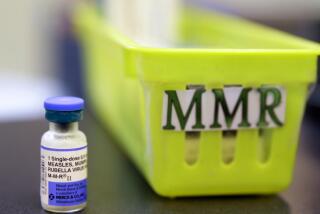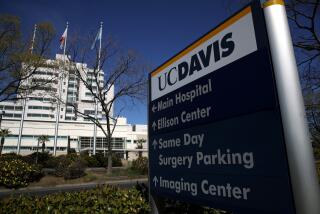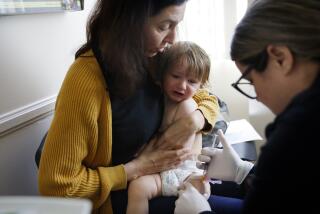A Killer Is Back : The Scarcity of Vaccine, Outreach Has Measles Running Wild : Health: The vaccination system is breaking down. So far, 34 children have died in California.
âMom, Iâm hungry,â Hector Lopez used to say when his mother came home from cosmetology school. âNobody feeds me around here.â
âNobody feeds you?â sheâd exclaim in mock exasperation, pointing out the big snacks his older sister had given him.
âYeah, I forgot,â Hector would laugh.
Donna Lopez smiles secretly about her chubby 10-year-old boy, then a shadow falls across her eyes. Hector died of measles in February.
He was a victim of the worst measles epidemic in California in over a decade. Thirty-four deaths--most of them among children under 4--and more than 4,000 cases have been reported so far in 1990, a 10-fold increase over 1989. Many more children will die unless a comprehensive vaccination and revaccination program is instituted.
Measles was once virtually wiped out in California. When a case first appeared at Los Angeles County-USC Medical Center a few years ago, medical residents couldnât identify it. Now, the hospital admits five cases a day. Minorities are particularly hard-hit. There have been three deaths on the Morongo Indian Reservation in San Bernardino County. In one Fresno hospital, eight Hmong people have died of measles.
The rise of the epidemic reflects plunging vaccination levels nationwide. One-third of American babies donât have all needed vaccinations by the governmentâs recommended 18-month deadline. Half of the children in inner cities donât have complete childhood vaccinations until they enter school. This threatens babies and unvaccinated adults who have not previously had measles. School-age children generally have the best measles survival rate, but even otherwise healthy kids can die or suffer permanent brain damage.
Measles is just the tip of the iceberg of the unmet health needs of children, who are both the poorest age group in the United States and the most poorly served by the medical community.
âIn the past, a new vaccine rapidly became available to all children,â says Dr. Edgar Marcuse of the American Academy of Pediatrics. Half received it through private doctors and the other half through public clinics. But now the vaccination system is breaking down; under-funded and understaffed clinics were not prepared for the resurgence of measles. The vaccine is scarce and expensive, as is the outreach needed in an era when more and more people canât afford routine health care.
Hector had a healthy appetite for life. He loved Garfield and pizza and riding his bike and playing Nintendo with his big brother, Richard. He didnât like âspinnich, slopy joys, suishi and green beans,â according to the brief autobiography he wrote in school. âMy favorite birthday was when we went to the circus. I ate cotten candy and I seen the trapeez.â
Every day he rode the bus 20 miles from his insular gang-dominated neighborhood in East San Diego to Sunset View Magnet School, with its breathtaking view of the Pacific. His mother didnât send her children there because of the beauty, but because she valued an education and didnât want them âin a bad crowd with gangs.â
When Hector started school, heâd had all his shots, his mother says. But, like so many parents, she didnât know that one measles vaccination is not sufficient protection. Last July the American Academy of Pediatrics began recommending two doses of the vaccine for all children and, where there are school outbreaks, revaccination for all students and their siblings. The U.S. Public Health Service also recommends two doses--one by 18 months, and a second upon entering school. Congress has not appropriated sufficient funds to provide a first dose to all children who must rely on public clinics, much less for revaccination. Yet the federal government may have to spend as much as $40 million to control the outbreak.
America now falls behind some Third World countries in its perilously low vaccination levels, and some fear that polio may return.
California could change at least this stateâs spending priorities. A bill authorizing an $11.8-million program of early-childhood health care, including immunization and outreach, will be considered next month by the Senate Appropriations Committee.
âHector was a happy child, always full of smiles,â his mother remembers. He used to tell her, âWhen I grow up, you know what kinda house Iâm gonna buy you?â
âWhat, mi hijo? â
âA fixer-upper. That way I can fix it just the way you want it.â
When Hector and his brother Richard were exposed to babies with measles, their mother thought nothing of it. After all, her boys had been vaccinated. When Richard told her he had a headache, she thought it was just a cold coming on. Over the weekend, Hector caught it. She put them to bed. Monday, when she came home, âthey were just laying there, silent; they had no strength.â
She rushed them to a small community hospital, where a doctor diagnosed measles. He prescribed plenty of liquids, Tylenol and diarrhea medicine, and told the mother not to worry. Then he sent the boys home.
On the second day, Hector whispered, âJust sit by me. Hold my hand, Mom.â
His feverish body went from hot to cold. Then he stayed cold. She began dressing him to go to the hospital. He got as far as the living room. His teeth tightened. His eyes rolled up. He went into convulsions.
âWe put him on the floor over there,â Donna Lopez recalls, pointing to a patch of carpet. âWe tried to give him mouth-to-mouth. I kept yelling, âMy sonâs dying.â It seemed like forever before the ambulance came.â
Hector and Richard were brought back to the same hospital. For two hours she waited. âYou pray and pray. God has listened for a long time. But heâs not gonna listen that time. If it hadnât been for Richard being in the other room, I couldnât have survived.â
The doctor told her that Hector was dead and, in the next breath, said that she shouldnât worry about Richard. This time, she didnât follow his advice. She demanded that they do something more for Richard than they had for Hector. Richard was transferred to Childrenâs Hospital, where they put him in intensive care.
âWhereâs Hector? Howâs Hector?â he kept asking in his fever.
By then, Donna Lopezâs two youngest children also had measles. The day she buried Hector, she had three children in the hospital.
Grieving is hard for a death that could have been prevented. On a warm afternoon in May, the little ones scuffle in the living room. Sunlight streams on the green carpet where Hector collapsed. A hand-made Motherâs Day decoration trails faded paper streamers. Roses bloom by the walk and cypress trees rise on the hill.
âYou and God are the most speishel peeple in my life,â Hector wrote in a Motherâs Day card last year. âI love you and God very much.â
Donna Lopez puts down the card and looks at the counter where Hector used to watch her cook. He was always asking for a sip of coffee. âI wouldnât let him have any,â she muses. Her brown eyes fill to the brim. âNow I wish I had given him more coffee.â Contemplating all the things she would have liked to give Hector, her voice deepens. âIsnât it funny? They have enough money for weapons, but thereâs no money to give our kids a second shot. My son was worth more than $40!â
She urges parents to get measles shots --$40 with a private doctor, free at a public clinic--even if itâs a financial sacrifice. She cautions them not to be easily turned away from care when their children are very sick.
When she took the boysâ bunk bed apart after Hector died, she found some words he had written on the bottom of his brotherâs bunk: âRichard and Hector together, forever.â She shudders to think how close they came to being together in death.
More to Read
Sign up for Essential California
The most important California stories and recommendations in your inbox every morning.
You may occasionally receive promotional content from the Los Angeles Times.










